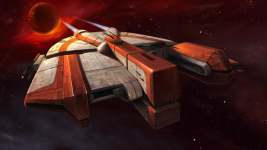Holodeck: Holy Grail or Hollow Promise? Part 1+2 (complete story)
By
Warren Spector Wed 31 Jul 2013 3:00pm GMT / 11:00am EDT / 8:00am PDT
 Warren Spector isn't so sure the industry will be able to create a holodeck gaming experience that's actually fun
Warren Spector isn't so sure the industry will be able to create a holodeck gaming experience that's actually fun
For years game developers, game players, science fiction fans (generally) and Trekkers (specifically) have been told - and have been telling themselves - that the trajectory of video game history leads inevitably to a Star Trek-inspired Holodeck.
Since first bursting onto the scene in the 1980s, Jaron Lanier, generally credited as the first person to describe the potential of "virtual reality," has argued that
something like the holodeck was unavoidable. Since then, he has been one of the leading evangelists for a fully immersive future. As recently as June of this year, in
New Scientist magazine, he reiterated his desire to see that dream become a reality:
"I believe that the Holodeck as Holy Grail has the potential to lead us down a blind alley toward a dead end future"
Instead of thinking of it like a very 3D movie, or a video game that you're inside, I think what virtual reality is going to be like is a new kind of a medium where you're playing with your own identity, and that's what's so interesting about it… it's almost like you're exercising these forgotten little corners of your brain, some really old corners that evolved to actually control different bodies deep, deep, deep back in our evolutionary past. And that kind of very profound, intimate sense of experience is really what virtual reality's all about.
Similarly, interactive media thinkers like Janet Murray have written persuasively about the appeal of the "Star Trek future." In her 1997 book, Hamlet on the Holodeck, she discusses the role of immersive simulation in the future of narrative laying out an explanation of, and template for, a future rich in virtual reality experiences that is still relevant 15-plus years on:
"The format that most fully exploits the properties of digital environments is not the hyper-text or the fighting game but the simulation: the virtual world full of interrelated entities, a world we can enter, manipulate, and observe in process."
If you haven't read Hamlet on the Holodeck you should probably do so - it's kind of a must-read for any game developer. I'll warn you, there are some very smart games industry folks who find the book as frustrating as it is educational! Still, a book that engenders strong feelings and gets people arguing is worth a read, right?
More recently, at USC, there's a team working on something called
"The Holodeck Project". (Clearly, though smart, talented, and driven by a Star Trek inspired mission to "go where no man has gone before" they need a marketing person to work on their naming skills). Regardless, here's what they have to say about the goals they've set for their work:
The holodeck has given us woodlands and ski slopes… figures that fight… and fictional characters with whom we can interact. Or so we were promised many years ago by a certain Jean-Luc Picard. But now we actually might have an actual Holodeck to actually run around in and actually fight baddies in… [T]he Holodeck is a bit different to the [Oculus] Rift: It's not just a head mounted display, it's a full virtual reality experience.
"I have a rule that's stood me in good stead over the years - never build a game that depends on potential buyers owning a peripheral in order to play"
And finally, if anyone requires more evidence of the pervasiveness and persuasiveness of a Holodeckian future, the most recent sighting I've seen can be
found in an article by Jeff Grubb, writing for the VentureBeat website:
The Holy Grail of immersive gaming is Star Trek: The Next Generation's holodeck - a room that you can enter that becomes an interactive experience and overwhelms your every sense. It's a concept so far-fetched that it still feels like we're a hundred years away from it, and we probably are… For something to qualify as a holodeck, it must trick your every sense…
Full disclosure - I worked with Jeff back at TSR and consider him a smart guy and a friend. Despite our history together, I can't go where he's going, any more than I can go all the way with Lanier, Murray, and other VR/Holodeck evangelists.
In fact, I believe that the Holodeck as Holy Grail has the potential to lead us down a blind alley toward a dead end future.
I realize I'm swimming against the current here - what with the slavering anticipation for the Oculus Rift VR rig, reports of Holodeck-like projects from Sony and recent Microsoft Kinect-driven VR patents. But hear me out.
Here's my contention:
If we're careful and thoughtful in our approach to predecessor technologies like virtual reality and augmented reality, as well as to Holodeck-style full immersion down the road, we might end up in a great place - a place as compelling as the world Lanier, Murray, Grubb et al envision.
But if we're
not careful, if we
don't consider what VR, AR and Holodecks can and cannot do well, we'll just end up spending a lot of money and expending a lot of effort giving users something
we think is cool, something those users
think they want, but which will inevitably disappoint.
"Folks who go first often go bust. Players who buy early can end up broke"
This may seem obvious - do smart stuff and good things happen - but from much of what I read and hear, from all the gushing over headsets and new peripherals for interacting with things on the screen, it's obvious to me that a lot of people aren't thinking about the pitfalls ahead. For that reason, I'd like to go through some potential problems we'd better think about - and soon.
Pitfall #1: Do people really want VR, AR or Holodeck enough to buy a peripheral to experience it?
I have a rule that's stood me in good stead over the years - never build a game that depends on potential buyers owning a peripheral in order to play.
No matter how cool the game or how cool the peripheral, only a portion of the potential audience will have (or be willing to buy) something new to get the full experience of your game.
Heck, even a peripheral that's packaged with hardware can be a sales-limiting factor. Sometimes the old ways are the best ways and, today, lots of people are just fine with a keyboard or controller - no surprise given that these ways of interacting with a computer or console have been refined to razor-sharp effectiveness by thirty-plus years of use and mastery. People like a controller connected to a TV or monitor they already own. Very few, if any, "normal humans" want or need more immersion than that. Who wants to learn a whole new way of experiencing and interacting with a virtual world? By and large, people just want to play. Anything that gets in the way of that reduces the likelihood of people playing.
Clearly, there are some big hurdles to overcome here. You can say we're still in early days of gaming, let alone VR, AR and Hdeck. You can say, of
course prices are going to be high and sales limited to early adopters. In other words, you can say that an audience limited by the need for a peripheral is okay - we have to start somewhere, right?
Not so right, I fear. Folks who go first often go bust (see Cybermaxx and Forte). Players who buy early can end up broke (yeah, I'm looking at all you Apple Newton owners out there). It's all too likely that the lack of a sufficiently large audience will lead to lack of developer and publisher support, which will lead to peripheral creators running into a brick wall we in the trade call "no money". And no money for anyone on the creation-distribution-play spectrum, regardless of where they fall on it, means the Holodeck (and VR and AR) may be further away than current technology would lead one to believe. They may
never catch on…
In my book, when you require a peripheral "purchased separately," as they say in the commercials, you always lose. Anyone see peripheral-free VR, HR or HDeck? Uh-huh. Didn't think so.
Pitfall #2: How do you control this crazy thing?
One of many things we learned in the VR gaming circles of 20 years ago was that the range of mobility of the human neck limited a player's ability to experience even the most meticulously designed and immersive virtual world. Unless you were willing to stand while you played, or you sat in a chair that swiveled 360 degrees, VR didn't add enough to the experience of play to balance out the cost and deficiencies of the hardware. (And watch out for deadly python-like cords as you rotate to take in your oh-so-compelling virtual surroundings).
"How many people really want to walk, run and jump to navigate a virtual world?"
And that is just the tip of the iceberg when it comes to interfacing with a virtual world. Falling into a 3D space… feeling like you're really there in an alternate world… In a very real sense, that's the easy illusion to deliver to users.
The problem of how you interact with an illusory immersive world? Now
that is one tough problem.
Creating a good head-tracking headset, while cool, is just the first hurdle. Assuming the full immersion of a Holodeck is even possible, and it seems likely it will be, probably sooner than anyone expects, what about the interface between user and device?
In a VR world, are we supposed to use a Wii Remote or something like it? In an AR world, are we supposed to flap our arms around, looking rather foolish as we do so? In a Holodeck experience are we supposed to run, jump, kick and punch?
How do you interact with a virtual world? (Remember, your solution has to be as seamless and refined as the mouse, keyboard and/or controller…) Who among us wants to walk and run and actually swing a sword for hours? How will you ride a virtual horse, climb a wall, or pick up the inevitable crate?
Head-tracking sounds great. If you want to look up, just look up. Check out your flank and turn right or left? Totally do-able and cool. Look behind you?… Oh, wait… hm… maybe do a full Exorcist and swivel your head 180 degrees? Maybe you have to get up off the couch and turn around? Use a mouse or keyboard you can't actually see in VR - and don't
want to see in AR or a Holodeck?
Put another way, how many people really -
really - want to walk, run and jump to navigate a virtual world? How many people really want to swing a sword for 5-10 (or 100) hours? I think we can agree on the answer - not many, for all the enthusiasm expressed.
A TV screen, a mouse and/or a keyboard are looking a little better, aren't they? If the new VR/AR/Hdeck peripheral you have to go out and buy makes such things harder rather than easier, why bother? You might as well go join a gym and get some exercise that way.
It's tough but not impossible to imagine solutions to control/interaction problems in a VR world, but being the immersive tech that's closest to what we already have, that's not much of a surprise. AR is certainly going to be harder, UI-wise (and that's assuming you can solve all sorts of visual and occlusion problems!). In an AR environment, you start with the movement problems I already mentioned, but then you also have to deal with the problem of interacting with real objects and virtual ones (and having the virtual objects then interact themselves with the real ones!). AR kind of makes my head hurt… The Holodeck? I don't even want to think about the interface and interaction problems there.
And remember - if doing things in a VR/AR/Hdeck world is harder than it is with the tried and true of a controller refined over decades of use, what use is a Holodeck at all? An immersive experience that, thanks to clunky UI, constantly reminds you that you're in a virtual world is going to drag you in and out of the experience every few seconds. That's makes it extremely unlikely users will be able to get into the desired flow state than they can in older, seemingly less immersive virtual environments.
 Pitfall #3: All costs and problems aside, does anyone even want the full-on holodeck experience?
Pitfall #3: All costs and problems aside, does anyone even want the full-on holodeck experience?
Just to get it out of the way, I'd argue that VR and AR at least have the potential to enhance the power of immersive experiences. The holodeck promises to add little to that and will, I fear, end up being something no one really wants.
People
think they want open-ended simulations of entire worlds - I was just at San Diego Comic Con a few weeks ago and I guarantee you there were lots of people in the gold, blue and red tunics of Starfleet Command who really want a Holodeck to call their own! (True confession? I had a near-biblical internal battle to resist buying one of those gold tunics myself...)
The big problem with Hdeck development is... well, there are a ton of hardware and software issues. But I'd argue that the real problems are conceptual - solvable, maybe, but requiring a radical rethinking of what an Hdeck can and should be.
Specifically, read up on the Holodeck and, with very few exceptions (notably Janet Murray, mentioned earlier) the dreamers dreaming about it seem to think it's enough just to
be in a virtual world. There's a belief that convincing geometry plus deep simulation plus AI plus rules equal a satisfying experience:
"Look, I'm at Gettysburg!"
"I'm riding a horse on the Scottish moors!"
"I'm living on Tatooine!"
Or (you know it's going to happen...) "I'm in a porn flick!"
All of those experiences sound fascinating - seductively so. And seeing the Holodeck on Star Trek, with all the boring and technically challenging aspects edited out in classic Hollywood fashion, makes full immersion look great. But in actuality, I suspect most people would find open-endedness to have, at best, limited appeal.
And, not to be
too facetious, let's not forget that any time the Holodeck appears in a Star Trek episode you can pretty well be assured it's going to malfunction. It's a wonder anyone wants to take such a risk in the real world. But many do want to leave our world for a more adventurous or emotionally compelling experience. Let's think about the nature of the Holodeck experience, then.
Pitfall #4: What do you do in a Holodeck?
"Being" is great, but without something to do, it's kind of an empty existence. That's true in the real world and equally true in a virtual one.
And there's perhaps the biggest conceptual problem with Hdeck thinking these days. There's an assumption that solving the hardware and UI problems is all we need to do. There seems to be this idea that simulation alone is enough. Create a compelling virtual world... add virtual people, animals and things... add players.
Bing, bang, boom! People will flock to the machine that lets them be a lion for a while or visit the pyramids in the comfort of their own home.
Clearly, in my mind at least, it isn't enough to
go somewhere or
be something. You have to
do something. And VR can make the doing cool. I get that. But Holodeck? Maybe for training purposes. Maybe for visiting a long ago place or meeting people and personalities long gone. But for entertainment? I'm just not sure.
The problem with most of those who view the Holodeck as Holy Grail is that they downplay, deny or, usually, don't even consider the need for a "mediator" between hardware and fleshware. But someone has to create the software that guides the experience.
I can think of very few people thinking about the role of the "designer" responsible for bounding the Hdeck user experience. Too few are thinking about what it takes to channel users in virtual directions that make sense, that are interesting, that aren't just... well... being.
The Holodeck as "grail" gets a lot of press and occupies a lot of mindshare. The Holodeck as experience, as an opportunity simply to be somewhere or be something, that generates a lot of buzz, too. But the Holodeck as medium - as something goal-oriented and challenging and worth spending significant amounts of time with (time that could be spent in other pursuits)? That's not getting much attention at all.
You read about Holodecks in military training exercises... in practice surgeries... in virtual travel. But I'd argue that most, if not all, technological advances become commercially viable and "mainstreamed" when used for entertainment. And that means we need to think about the verbs of play, of storytelling, of action as much as, or more than, we need to think about graphics and controls. Those are critically important and may or may not be solvable. But for solutions to be meaningful, we need to think through the potential of the medium and begin trying to understand the role of the mediators who will make user... no...
player experiences meaningful, too.
A fully-simulated world with no goals, no narrative, and no purpose is a lot of work for nothing. Aimless wandering is the enemy of fun. And without a "creator," all you have is aimless wandering. Players must find their own fun, something they're demonstrably not very good at doing. Well, let me soften that statement -
most players aren't good at making their own fun.
(And before anyone brings up Minecraft, that's a very different animal, a sandbox game that's all about creation of content. The tools are there specifically to make creation easy. The Holodeck, as usually envisioned, is about exploration and unguided experience.)
Once the novelty of full immersion wears off (and I believe there's only so much "being a tiger" one can take before the thrill is gone), goal-orientation will be critical. The goal might be "save the princess" or "kill everything that moves" (god forbid to both). Or the goals can be "operate on this sick guy" or "terraform this planet." But you need goals to make a fully simulated world worth exploring. You need player constraints. You need something specific to accomplish.
And you need all of those things in a form that can't be as well expressed without all the rigmarole of headsets and treadmills and power gloves. At this time, I can't think of any experience that would be improved by a Holodeck. Not one.
Prove me wrong. Seriously. I hope someone can. Because, you see, I'm not all that psyched about the Holodeck, per se. What I am psyched about, and always have been psyched about, are the immersive possibilities VR and AR offer.
Surprising Revelation #1: I'm a Fan (Believe It Or Not)
As I wrap this up, and before the knives come out, let me be clear about one thing: I'm a longtime and enthusiastic supporter of all things VR.
As far back as 1994, I was producing first-person games that supported the leading VR devices of the day - remember Wings of Glory? Uh. Okay. How about System Shock? Even if you remember the games, you may not remember that in them we supported pioneering VR headsets like the Forte VFX-1 and Cybermaxx (which we sometimes referred to as the "Cyberbrick" for its weight and ergonomic... ahem... issues).
Back then, the head-tracking was serviceable, but the optics weren't close to being even "serviceable." And there was the weight (best measured in tons, if memory serves). Plus there was the unfortunate tendency to overheat once in a while and, you know, burst into flames. Seriously. I couldn't make that up.
Despite all those shortcomings, I saw an amazing future for such things and wanted desperately to be a part of it. Really feeling like you were in another world, seemed like the Next Step For Gaming. Looking around to see your friends and allies was incredibly cool. Keeping an eagle eye out for enemies? Oh, yeah!
But, back then, you couldn't read any text... dealing with menus was a nightmare... you still had to deal with keyboards and mice to interact... the weight of headsets back then was headache inducing and nose-crushing... and, as I said, there was that pesky fire problem.
I've heard that the Oculus Rift solves some or all of these problems. (If nothing else, it better deal with the fire issue!) But I haven't seen it, so I can't really say. I'm certainly hopeful that the issues above have been resolved in the last 20 years but, well, this is my dubious face. (If anyone wants to give me a demo, I'm totally up for it, by the way.)
What does the future hold?
Damned if I know! But here's my foolish attempt to divine what's coming:
VR? Sure. If what you're after is a more immersive but even more isolating experience than ever before. And don't forget you'll have to stand for hours to experience much beyond what a large screen monitor offers. I wouldn't say VR is "standard stuff" but it's not so far off from the 3D worlds we've been building for decades to bet against VR having a large and growing place in the gaming world.
AR? Also sure. Being out in the real world with virtual overlays sounds great. Once in a while. AR is one of the most interesting thing going on in games right now. The potential is there to do amazing things - things no game today, yesterday or in the foreseeable future has been able to do. The fact that no one knows with any degree of certainty what an AR game should look and play like is a bonus - the possibility of failure is huge. Who wouldn't want to mess with something like that?
A fully immersive, alternate world-creating Holodeck? That's a solution in search of a problem (and a solution that brings a host of its own problems along for the ride). My gut tells me we should just leave the Holodeck to Star Trek.
But let's assume all the problems of VR, AR and the Holodeck can actually be solved.
Is this the time VR is here to stay? Is AR the next big thing? Is the current flush of enthusiasm for these things really the first significant step toward the Holodeck?
Or is this, as I fear, just another false alarm, like the now (thankfully) fading reemergence of 3D movies, TV and games?
Look at the history of 3D in media and you see a clear pattern - 3D is hailed as the savior of movies, for example, every 30 years. The 1890s, the 1920s, the 1950s, the 1980s and, recently, the 2010s, what do we see? You betcha! 3D is back! Every time the film business needs a creative jolt or finds itself threatened by some new medium or business model, roll out 3D and rake in the bucks. For a while.
Similarly, VR seems to make an appearance every ten years or so - in the 80s, the 90s and now the 20-teens... This latest appearance seems at least marginally tied to the current chaos in the games business, making the growing enthusiasm for such things seem even more like the movie model.
In movies, 3D has never stuck. It comes, it goes, the glasses and projection systems get marginally better, Hollywood and the press go wild. Then nothing. Audiences don't care.
I'm betting it's the same thing with VR/AR and Holodecks. Rather than being the time such things stick I tend to think this is just another moment where media history repeats itself. The craze will last a while like a raging brush fire, then fade into nothingness.
Now for the big twist ending to this column:
I truly hope I'm wrong about everything I've said here. I hope someone - maybe one of you reading this - can prove me wrong. I now turn the stage over to you to do just that.
See you in cyberspace!
Quelle: Holodeck: Holy Grail or Hollow Promise? Part 1 | GamesIndustry International und Holodeck: Holy Grail or Hollow Promise? Part 2 | GamesIndustry International

.gif)











































